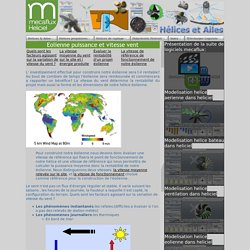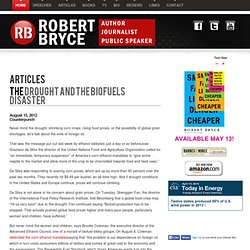

Info Eolien : la vitesse du vent. Vous êtes ici > accueil >> énergie éolienne >> Le vent Pages : 1 - 2 Connaitre la vitesse moyenne du vent en région et sur le site d'implantation est un des éléments déterminants dans le choix d'une éolienne.

La vitesse du vent en région La vitesse du vent est l'élément le plus important à prendre en compte dans le choix d'une éolienne domestique. En fonction de la vitesse moyenne du vent qui peut varier énormément selon la région et les micro-climats au sein d'une même région, le rendement d'une éolienne pourra être divisé par trois ou encore multiplié par deux. Nous vous conseillons avant tout de vous référer aux données de vitesse du vent publiées par votre région.
Vitesse du vent sur le site d'implantation Le critère le plus important est l'étude préalable de la vitesse du vent sur votre site d'implantation. Eolienne puissance et vitesse vent. Présentation de la suite de logiciels mecaflux: Modelisation helice aerienne dans heliciel Modelisation helice bateau dans heliciel Modelisation helice ventilation dans heliciel Modelisation helice eolienne dans heliciel Modelisation hydrolienne dans heliciel Modelisation helice kaplan dans heliciel.

Robert Bryce - Author/Journalist/Public Speaker. August 15, 2012 Counterpunch Never mind the drought, shrinking corn crops, rising food prices, or the possibility of global grain shortages, let’s talk about the evils of foreign oil.

That was the message put out last week by ethanol lobbyists just a day or so beforeJose Graziano da Silva the director of the United Nations Food and Agriculture Organization called for “an immediate, temporary suspension” of America’s corn-ethanol mandates to “give some respite to the market and allow more of the crop to be channelled towards food and feed uses.” Da Silva was responding to soaring corn prices, which are up by more than 60 percent over the past two months.
They recently hit $8.49 per bushel, an all-time high. And if drought conditions in the United States and Europe continue, prices will continue climbing. Chiffres clés - Moins de CO2 - blog de Thierry Maubeuge. Fiche 1.2 donnees physicochimiques rev avril 2011.pdf (Objet application/pdf) EECA Energywise.
Down to the wire: Inexpensive technique for making high quality nanowire solar cells developed. (PhysOrg.com) -- Solar or photovoltaic cells represent one of the best possible technologies for providing an absolutely clean and virtually inexhaustible source of energy to power our civilization.

However, for this dream to be realized, solar cells need to be made from inexpensive elements using low-cost, less energy-intensive processing chemistry, and they need to efficiently and cost-competitively convert sunlight into electricity. A team of researchers with the U.S. World's first ultra-thin, low energy molybdenite microchip tested. Back in February, Darren Quick wrote about the unique properties of Molybdenite and how this material, previously used mostly as a lubricant, could actually outshine silicon in the construction of transistors and other electronic circuits.

In brief: it's much more energy efficient than silicon, and you can slice it into strips just three atoms thick - meaning that you can make transistors as much as three times smaller than before, and make them flexible to boot. Well, the technology has now been proven with the successful testing of the world's first molybdenite microchip in Switzerland. How 3-D Photovoltaics Could Revolutionize Solar Power The Sun sends some 87 Petawatts of power our way and converting some small fraction of this into usable power is one of the key battlefronts in the fight to free the world from its addiction to oil.

One way to do this conversion is to turn light into electricity using flat photovoltaic panels. This form of power generation is rapidly expanding all over the world. But it suffers from various problems that prevent its more widespread adoption, particularly at higher latitudes where the amount of energy that can be converted varies dramatically throughout the day and by season too. A 50-year quest to isolate the thermoelectric effect is now over: Magnon drag unveiled. In a paper published in Nature Materials, a group of researchers at the Catalan Institute of Nanotechnology (ICN, Spain) led by Prof.

Sergio O. Valenzuela reports the observation of the magnon drag. This work ends a 50-year long effort to isolate this elusive thermoelectric effect. As electrons move past atoms in a solid, their charge distorts the nearby lattice and can create a wave. Reciprocally, a wave in the lattice affects the electrons motion, in analogy to a wave in the sea that pushes a surfer riding it. MIT researchers are printing solar cells on sheets of paper – Computer Chips & Hardware Technology. Paint-on solar cells developed.
Imagine if the next coat of paint you put on the outside of your home generates electricity from light -- electricity that can be used to power the appliances and equipment on the inside.

A team of researchers at the University of Notre Dame has made a major advance toward this vision by creating an inexpensive "solar paint" that uses semiconducting nanoparticles to produce energy. "We want to do something transformative, to move beyond current silicon-based solar technology," says Prashant Kamat, John A. New Solar Cell Gives Its "110 Percent" in Efficiency. Like Tebow, these new solar cells are giving their "110 percent" week in and week out.

(Source: ESPN) Gains to quantum efficiency could yield around a 35 percent gain in conversion efficiency, the key metric Using quantum dots -- tiny nanometer scale semiconductor crystals -- researchers at the U.S. Flexible Solar Cells Reach Record Efficiency of 18.7% Photo: Empa The Previous Record was 17.6% Scientists at Empa, the Swiss Federal Laboratories for Materials Science and Technology, have made flexible solar cells made of copper indium gallium selenide (CIGS) with a light-conversion efficiency of 18.7 percent, a new world record.

This milestone, about 1% higher than the previous record, might seem like a small step forward, but when looked at in the context of constant incremental improvement, it is significative. Solar Panels Are Cheaper Than We've Been Told. A Brighter Way to Make Solar Cells. Bright idea: This furnace uses lightbulbs, not heating elements, to treat silicon wafers. Making solar cells involves subjecting silicon wafers to temperatures in excess of 1,000 °C. The process normally involves the use of heating elements, and requires a lot of energy. A new optical furnace developed by researchers at the National Renewable Energy Laboratory in Golden, Colorado, heats up solar wafers by focusing light on them—a much more efficient process that uses about half the energy of a conventional furnace.
Nanotrees harvest the sun's energy to turn water into hydrogen fuel. University of California, San Diego electrical engineers are building a forest of tiny nanowire trees in order to cleanly capture solar energy without using fossil fuels and harvest it for hydrogen fuel generation. Reporting in the journal Nanoscale, the team said nanowires, which are made from abundant natural materials like silicon and zinc oxide, also offer a cheap way to deliver hydrogen fuel on a mass scale. "This is a clean way to generate clean fuel," said Deli Wang, professor in the Department of Electrical and Computer Engineering at the UC San Diego Jacobs School of Engineering.
The trees' vertical structure and branches are keys to capturing the maximum amount of solar energy, according to Wang. That's because the vertical structure of trees grabs and adsorbs light while flat surfaces simply reflect it, Wang said, adding that it is also similar to retinal photoreceptor cells in the human eye. The vertical branch structure also maximizes hydrogen gas output, said Sun. Cheap Solar Power at Night Solar power has two main problems: it’s expensive, and it’s intermittent, since the output of a solar power plant depends on the time of day and cloud cover.
Halotechnics, an early-stage solar-thermal startup, could help solve both problems.